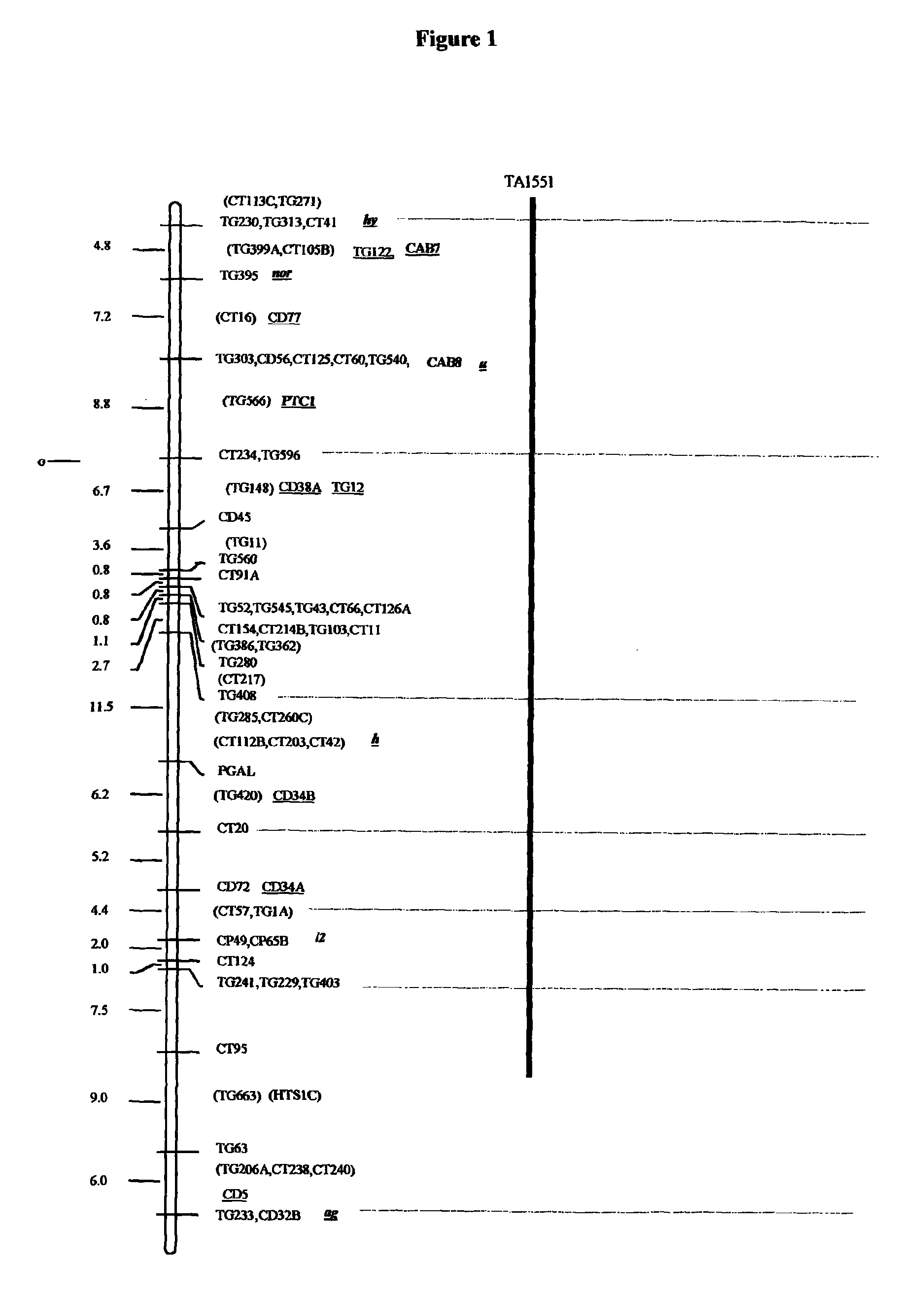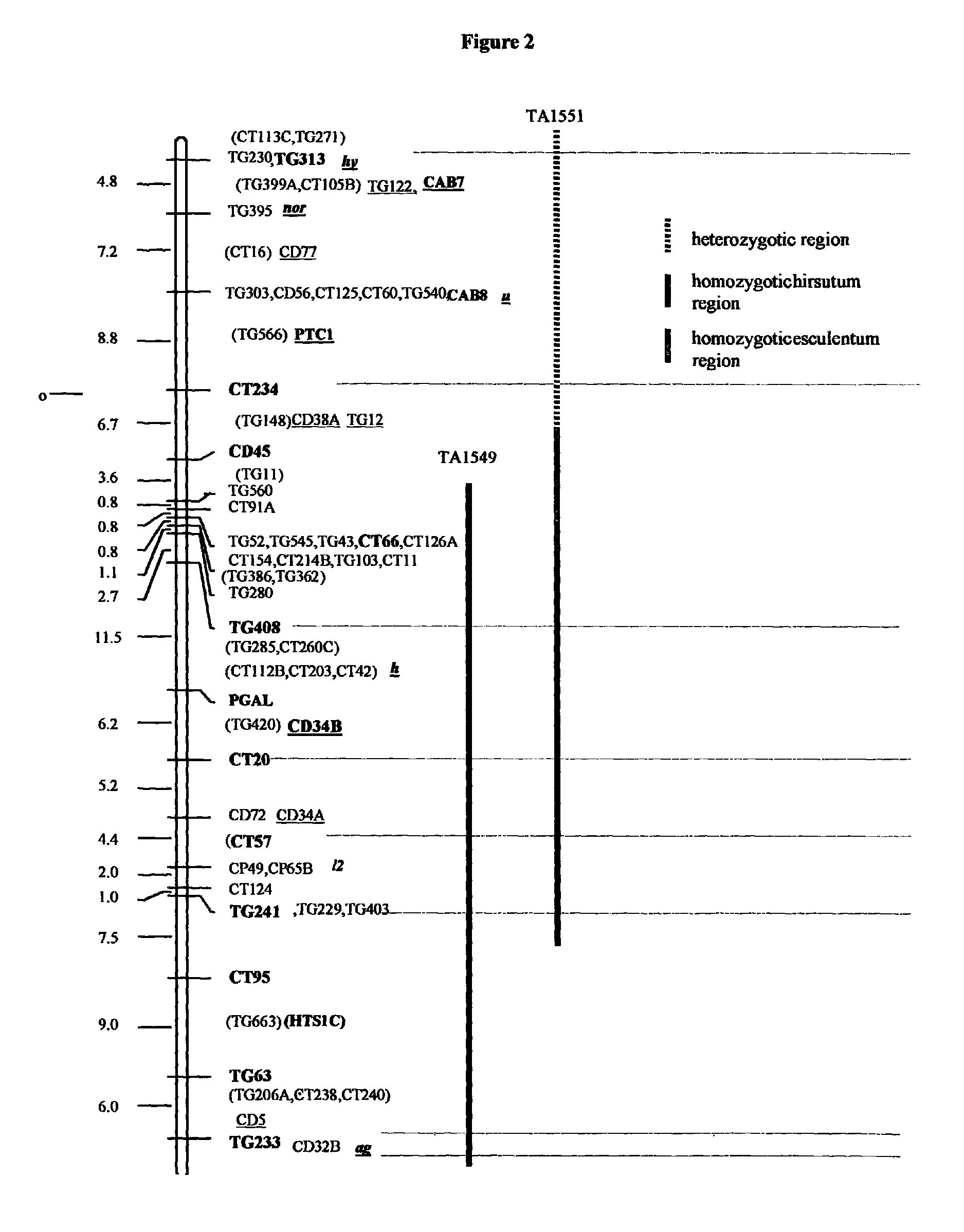Tomato plants that exhibit resistance to botrytis cinerea
a technology of botrytis cinerea and tomato plants, applied in the field of plant breeding and molecular biology, can solve the problems of girdling the stem of the infection, killing the plant, irregular, etc., and affecting the maturation of the frui
- Summary
- Abstract
- Description
- Claims
- Application Information
AI Technical Summary
Benefits of technology
Problems solved by technology
Method used
Image
Examples
example 1
Resistance to Botrytis in Lycopersicon hirsutum×L. esculentum Backcross Recombinant Inbred Lines
[0105]Seeds of the following Lycopersicon hirsutum×L. esculentum backcross recombinant inbred lines (hereinafter “RIL”) were sent to Latina, Italy for resistance evaluation under greenhouse conditions in the year 2000. Seeds were planted into soil in transplant trays and grown in the greenhouse between 20.degree. C. and 24.degree. C. for approximately 6 weeks. Specifically, the seeds were from the following lines: LA1777, TA1551, TA1330, TA1276, TA1105, TA1277, TA1541, TA1324, TA517, TA1266, TA1544, TA1316, TA1539, TA1121, TA1112, TA1545, TA1562, TA1258, TA1304, TA1280, TA1548, TA1127, TA1535, TA1540 and E6203. All the lines are publicly available from the C. M. Rick Tomato Genetics Resource Center, Department of Vegetable Crops, University of California, One Shields Avenue, Davis, Calif. 95616 (available on the worldwide web at tgrc.ucdavis.edu). These lines have been described by Monfor...
example 2
Resistance to Botrytis in Lycopersicon hirsutum×L. esculentum Backcross Recombinant Inbred Lines
[0125]To further evaluate the resistance observed in line TA1551 in the greenhouse screen in 2000 (see example 1) seeds of the following Lycopersicon hirsutum×L. esculentum backcross recombinant inbred lines were sent to Latina, Italy for resistance evaluation under greenhouse conditions in 2001. Seeds were planted into soil in transplant trays and grown in the greenhouse between 20° C. and 24° C. for approximately 6 weeks. Specifically, the seeds were from the following lines: LA1777, TA1551, TA1551-F1, TA1339, E6203 and Max. Except for TA1551-F1 and Max, the other lines are publicly available from the C. M. Rick Tomato Genetics Resource Center, Department of Vegetable Crops, University of California, One Shields Avenue, Davis, Calif. 95616 (available on the worldwide web at tgrc.ucdavis.edu). The recombinant backcross inbred lines TA 1551 and TA 1339 are described by Monforte and Tanksl...
example 3
Resistance to Botrytis in Lycopersicon hirsutum×L. esculentum Backcross Recombinant Inbred Lines
[0151]To obtain a more detailed understanding of the region on chromosome 10 that is responsible for resistance, additional Lycopersicon hirsutum×L. esculentum backcross recombinant inbred lines containing chromosome 10 introgressions were evaluated along with lines that did not contain chromosome 10 introgressions in the greenhouse screen at Latina Italy in 2002. Seeds of the following Lycopersicon hirsutum×L. esculentum RIDs were sent to Latina, Italy for resistance evaluation under greenhouse conditions. Seeds were planted into soil in transplant trays and grown in the greenhouse between 20° C. and 24° C. for approximately 6 weeks. Specifically, the seeds were from the following lines: TA1331, TA1337, TA1339, TA1546, TA1549, TA1551, TA1552, TA1555, TA1559, TA1564, TA1630, TA1654, LA1777, and E6203. These lines are publicly available from the C. M. Rick Tomato Genetics Resource Center, ...
PUM
| Property | Measurement | Unit |
|---|---|---|
| temperatures | aaaaa | aaaaa |
| temperatures | aaaaa | aaaaa |
| temperatures | aaaaa | aaaaa |
Abstract
Description
Claims
Application Information
 Login to View More
Login to View More - R&D
- Intellectual Property
- Life Sciences
- Materials
- Tech Scout
- Unparalleled Data Quality
- Higher Quality Content
- 60% Fewer Hallucinations
Browse by: Latest US Patents, China's latest patents, Technical Efficacy Thesaurus, Application Domain, Technology Topic, Popular Technical Reports.
© 2025 PatSnap. All rights reserved.Legal|Privacy policy|Modern Slavery Act Transparency Statement|Sitemap|About US| Contact US: help@patsnap.com


